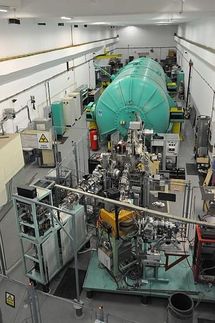Chemical complexity promises improved structural alloys for next-gen nuclear energy
Researchers in an Energy Frontier Research Center led by the Department of Energy's Oak Ridge National Laboratory are investigating ways to design structural materials that develop fewer, smaller flaws under irradiation. The key is exploiting the complexity that is present when alloys are made with equal amounts of up to four different metallic elements.

In complex alloys, chemical disorder results from a greater variety of elements than found in traditional alloys. Traces here indicate electronic states in a complex alloy; smeared traces reduced electrical and thermal conductivity.
Oak Ridge National Laboratory, U.S. Dept. of Energy. Image by G. Malcolm Stocks
"Chemical complexity gives us a way to modify paths for energy dissipation and defect evolution," said first author Yanwen Zhang, who directs an Energy Frontier Research Center, called "Energy Dissipation to Defect Evolution," or "EDDE," funded by the U.S. Department of Energy Office of Science. The growing center is nearly 15 months old and brings together more than two dozen researchers with experimental and modeling expertise.
Recipes for success
Recently, a very different class of materials has generated a great deal of interest. In these special alloys, several different types of atoms, in equal proportions, distribute randomly in a simple crystal lattice. High entropy alloys comprising five or more species are exemplars. Indeed, researchers at Berkeley and Oak Ridge labs have recently shown that some of the alloys, discovered about a decade ago, exhibit exceptional strength and ductility at cryogenic temperatures. In all these alloys, chemical disorder is intrinsic to their behavior.
In comparison, the goal of the EDDE study was to find how compositional complexity can lead to differences in heat and electricity conduction and influence defect dynamics at early stages that affect the robustness of a structural material at later stages. The results revealed how advanced alloys achieve greatly enhanced irradiation performance through chemical diversity.
It took a team with many skills to explore a novel set of alloys containing nickel and equal amounts of other elements. One recipe tried duos of ingredients whereas others tried triplets or quartets. The chemical elements, distributed randomly in the crystal lattice, create unique site-to-site, microscopic distortions. The lattice nonetheless retains its macroscopic crystalline structure.
Integrating theory and experiment, the scientists grew alloy crystals of unrivaled quality, calculated changes to electronic structures and intrinsic transport properties that were induced by chemical disorder, and confirmed the computational results with experimental measurements of each crystal's electrical resistivity and thermal conductivity. The results from ion irradiation, modeling of defect production, ion-beam analysis and microstructural characterization of the irradiated alloys show significantly reduced defect production and damage accumulation in these materials. The findings suggest a link between slow energy dissipation and suppressed defect evolution.
"We observed suppressed damage accumulation with increasing chemical disorder from pure nickel to binary and to more complex quaternary [alloys]," Zhang said.
The EDDE study showed that fewer and smaller defects were produced as the alloy complexity increased. It also showed dramatic improvement in properties related to resistance to radiation damage.
It turns out that just increasing the number of elements in the recipe doesn't necessarily produce the best alloys for targeted functions. Determining what combinations work best depends on aspects including local structural distortions and chemical, electronic and magnetic properties of constituent atoms.
With dramatically lower electrical and thermal conductivity than traditional alloys, next-generation alloys based on recipes with high chemical disorder may slow energy dissipation and experience far fewer of the defects that weaken structural materials over time. Evidence that slow energy dissipation can remove some local defects even hints at the possibility of developing self-healing nuclear structural materials.
Further studies are needed to understand how alloy complexity can tailor material properties. The knowledge gained may spur new design principles of alloys for advanced energy systems and reduce trial-and-error to accelerate "materials by design."
"These insights into defect dynamics at the level of atoms and electrons provide an innovative path forward toward solving a long-standing challenge in structural materials," Zhang said.
Original publication
Yanwen Zhang, G. Malcolm Stocks, Ke Jin, Chenyang Lu, Hongbin Bei, Brian C. Sales, Lumin Wang, Laurent K. Béland, Roger E. Stoller, German D. Samolyuk, Magdalena Caro, Alfredo Caro & William J. Weber; "Influence of chemical disorder on energy dissipation and defect evolution in concentrated solid solution alloys", Nature Comm.; 2015





























































